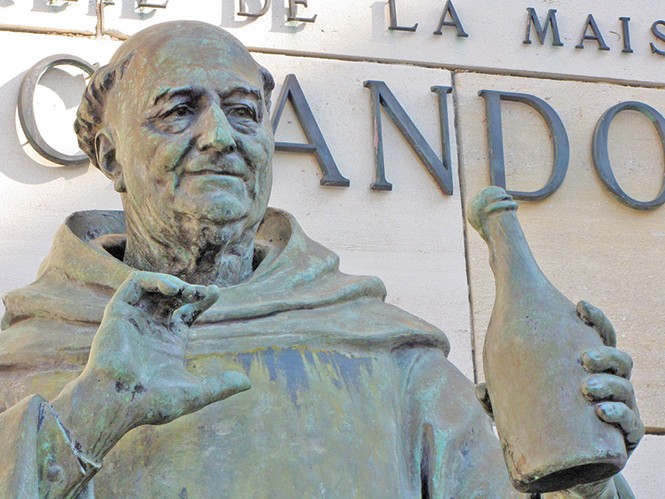One of the highlights of my recent visit to France's Champagne region was spending the better part of a day at the glamorous house of Moët & Chandon, also known simply as Moët. The day began with selfies of the missus and me with the statue of Dom Pérignon, which welcomes visitors to the cellars, and ended with a tasting of various vintages hosted by the house sommelier. Days like that don't suck.
Located in Épernay, Moët is France's largest sparkling-wine producer, first established by wine trader Claude Moët in 1743 as Moët et Cie (Moët & Co.). His grandson, Jean-Rémy, transformed the company into Moët & Chandon toward the end of the 18th century and introduced the world to Champagne, helping to create global appeal for French bubbly that thrives to this day.
You learn a lot about Champagne in general—and this winery in particular—when you spend the day with Moët's superviseur visites, Marie-Filomène Martins. For example, the tradition of Grand Prix and Formula 1 race drivers spraying Champagne to celebrate a victory dates back to the celebrations of the winners of the 24-hour Le Mans race in 1967. That's when driver Dan Gurney was handed the Jeroboam of Moët, and used the bottle like a firehose to spray the nearby guests and fellow drivers. Today, the man considered by many to be the greatest tennis player of all time, Roger Federer, is Moët's brand ambassador—a class act if ever there was one. And such was her love of Moët & Chandon that the Marquise de Pompadour, mistress of King Louis XIV of France, declared, "Champagne is the only wine in the world that makes every woman beautiful."
Visiting these cellars is simply breathtaking. Spanning some 17.5 miles and situated 30-100 feet below ground, the labyrinthine subterranean cellar tunnels take visitors past new and non-vintage Champagnes, as well as vintage offerings, including the much-heralded Dom Pérignon. I won't go into all the minutiae of Champagne-making here, since I've done so previously, but suffice it to say that over the past 270-plus years of bottling bubbly, this winery has it nailed.
The best-seller and most well-known in Moët's lineup is Moët Impérial Brut ($49.99), a unique style of non-vintage created in 1869. The house's flagship Champagne owes its name to Emperor Napoleon Bonaparte, and some historians say that the art of sabering open bottles with a sword is also credited to Napoleon—his way of celebrating victories. Impérial's classic blend of pinot noir, pinot meunier and chardonnay is the signature house style—a wine that is both elegant and subtle, while simultaneously offering sumptuous white-fruit flavors of pear, apple and peach.
For some fun fizz on a hot summer day, give Moët Ice Impérial ($59.99) a try. It's designed to be served over ice, with bright flavors of tropical fruits, stone fruits and hints of raspberry and ginger. As regular readers of this column probably know, I'm a big fan of rosés, both still and sparkling. During our visit, we got a sneak peek (or sip) of Moët & Chandon Grand Vintage Rosé 2008 ($69.99), which has just been released. Its delicate bouquet is followed by succulent strawberry notes on the palate—a spectacular vintage that you could drink now or cellar for a special occasion. More affordable, but also enticing, is Moët & Chandon Rosé Imperial ($55), a gorgeous and versatile wine that pairs well with foods from sushi to paella. Santé!
More by Ted Scheffler
-
Flavor on the Western Front
Nomad Eatery ups the ante for off-airport eats.
- Dec 13, 2017
-
Under the Christmas Tree
Holiday gifts for cooks, foodies and winos
- Dec 6, 2017
-
Spreading the Love
Amour Café creates simple yet scrumptious fare.
- Nov 29, 2017
- More »





